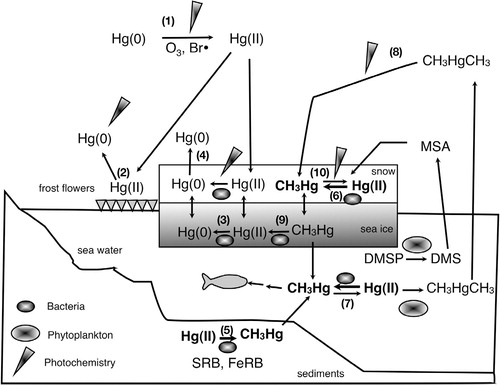Figures & data
Fig. 1 The biogeochemical cycle of mercury in coastal marine environments in polar regions. Major reaction and transport pathways, provided as numbers in parentheses in the figure, are: (1) atmospheric oxidation of Hg(0) to Hg(II); (2) photoreduction of newly deposited Hg(II) to Hg(0); (3) biological reduction of Hg(II) to Hg(0); (4) evasion of Hg(0) to the atmosphere; (5) methylation of Hg(II) to CH3Hg by sulfate-reducing bacteria (SRB) and iron-reducing bacteria (FeRB); (6) methylation of Hg(II) to CH3Hg by aerobic pathway and/or by photomethylation in snow; (7) methylation of Hg(II) to CH3Hg by algae and phytoplankton in the water column; (8) photochemical degradation of diMeHg in the atmosphere; (9) biological demethylation of CH3Hg to Hg(II); and (10) photochemical demethylation of CH3Hg in snow. Methylation pathways are highlighted by bold lettering. Note that these reactions and pathways may take place in various compartments of polar regions; for the sake of simplicity they are only marked in a representative compartment in the figure (see text for details). Dimethylsulfoniopropionate is abbreviated to DMSP, dimethylsulfide to DMS and methylsulfonic acid to MSA.

Fig. 2 The number of papers retrieved on 11 October 2010 from the ISI Web of Knowledge database, using the keywords indicated. The search was performed using Boolean operators to avoid references to unrelated topics. The descriptor “microbes” is used for clarity and is based on a search that was performed using the query Microbes OR Bacteria OR Archaea AND all other terms as indicated in the figure.

Table 1 A summary of the uniqueness of microbial transformations and research questions whose answers would enhance our understanding of Hg biogeochemistry in polar regions.